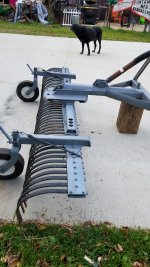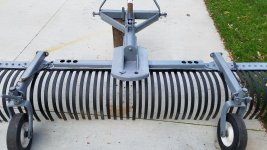How much crown do you have?
A flat road is doable, but requires a lot more maintenance. Almost every time it rains enough for runoff.
Hypothetically, if my driveway was 12ft wide, I'd want at least a 4" crown. Even then I'd hafta maintain the ridge just outside the tracks to prevent erosion down the track.
Steeper crown eliminates some of the maintenance. Down side is it's harder to stay on a steep crowned road if you get off the center.
Your GS is a very, very good tool for maintaining your type of driveway. Would it be possible to gain some crown by cranking the right side down so it cuts more and then always drive with the right side at the shoulder of the roadbed???
I'm not familiar with the use of a GS and have only operated one an hour or so.
The driveway has three distinct sections, the upper, the down hit mid section, and the lower muddy section.
The upper section I am trying to lower about 12 to 18 inches, this section has no crown but a very slight slant to the roadway towards the left.
The mid section is all down hill, usually it doesn't get as affected by the water run off. It is at more of a slant than the upper section but still has slight snaking effect of the water. No crown there just the slant in the road bed.
The lower section, the mud problem and with the way all of the upper land drains, I am thinking I need to address the water before determining how to grade the lower section. The lower section has not crown, it has a slant to the hog side of the land so drain off let the water go one way and then it drains to the lowest section and runs across the road.
When I first purchased the land and started by addressing the road, I dug up a cross section in the wettest p art of the lower section and put in some heavy gauge flexible sheet plastic I had hanging around, added some larger crushed stone, maybe 3"+, and then added some 3/4"+ on top. Let it stay that way and so far that is still intact but the area around it is still the mud hole.
Talking about this raised my awareness in two areas, one being the crowning and/or slanting of the roadway and the other is in my knowledge of the water in the area, I need to do what I canid crowning the top section, and the lower section but I think my main effort, after the rain stops, is to find a way to put in a better water drain no the side of the road. :banghead:

unch:
Time to put the BHon and start moveing some dirt and adding some stone to the drainage system. :duh:
OK so I've had a revelation,:cool2: I need to build a drain on the side of the WHOLE driveway, (1/4+ mile of drain, 12" wide, min., and 12" deep, min., some larger stone 3 or 4 inches, some heavy weed block but maybe some sort of heavy gauge flexible plastic, and some time !
Another job to add to the list but I think this will get the job done.
Thanks / Later

